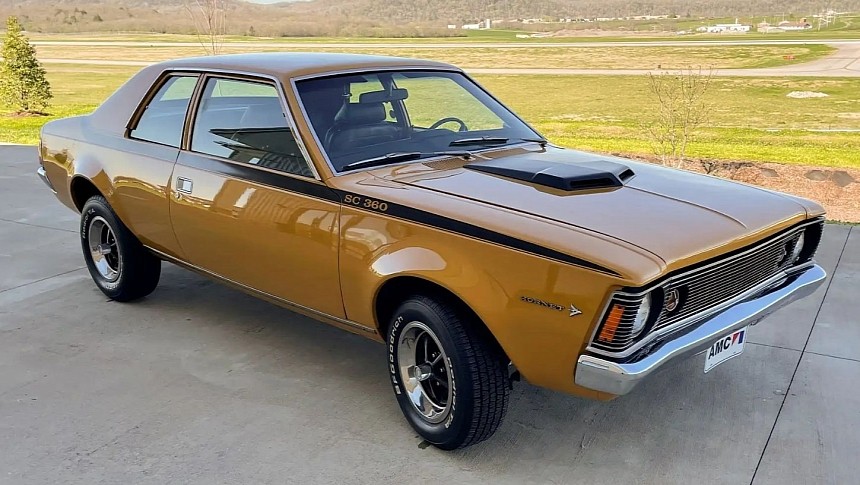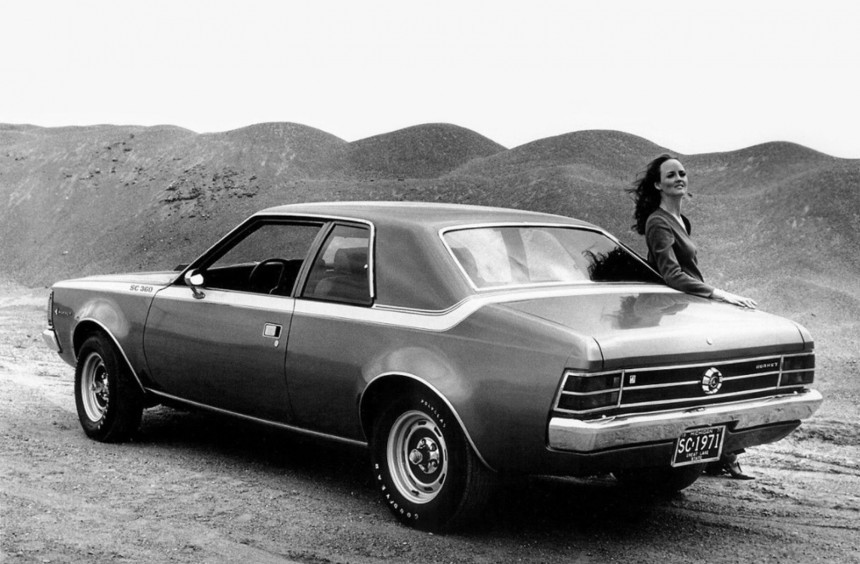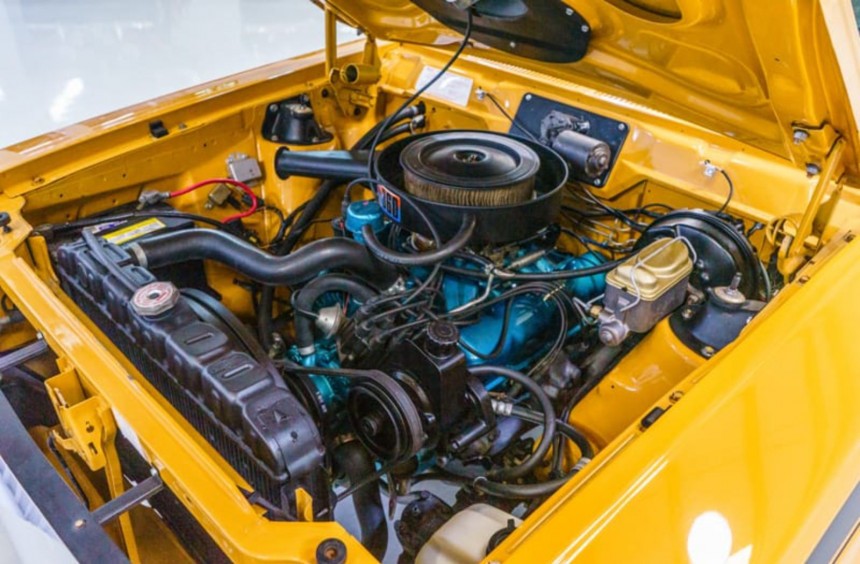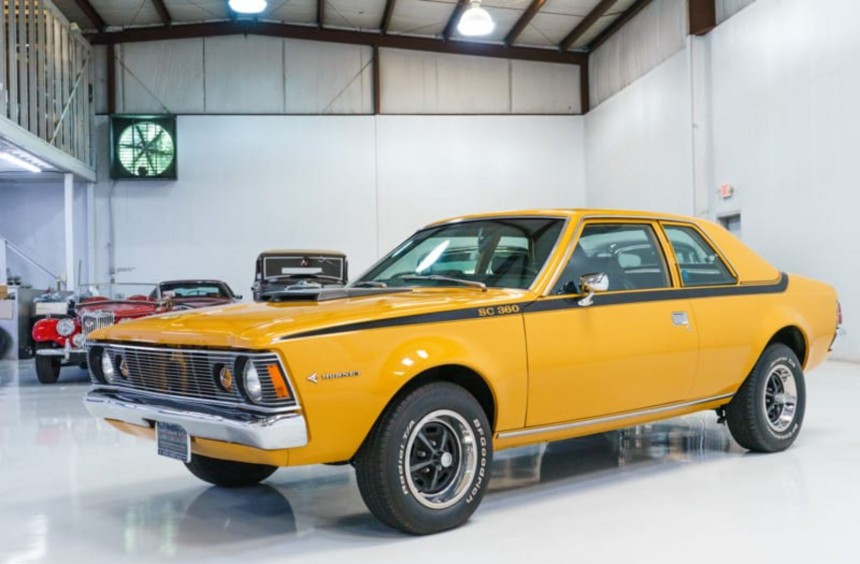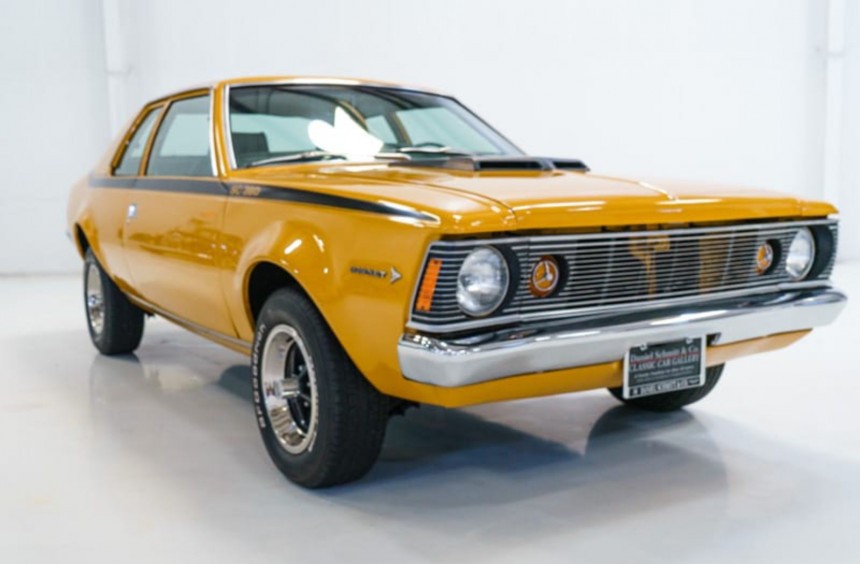The 1960s and early-1970s saw the birth of high-powered muscle cars that took the American market by storm and became global icons in the following decades.
Although Detroit's Big Three - comprised of the Ford Motor Company, Chrysler Corporation, and General Motors - were responsible for these legendary four-wheeled monsters, the Kenosha, Wisconsin-based American Motors Corporation (AMC) managed to compete with some fantastic muscle cars of its own, despite having fewer resources.
In 1954, the Nash-Kelvinator Corporation merged with the Hudson Motor Car Company in what was the largest corporate merger in US history. The resulting company, American Motors Corporation, initially attempted to become a thorn in the side of the Big Three.
Though it managed to compete with Detroit's finest to some extent, introducing many innovative features in its cars, by the mid-1960s, sales figures of AMC models were going downhill fast because they were becoming unappealing to the younger demographic.
Though it took some years to respond, AMC finally began to dig itself out of a financial hole during the 1968 model year with the launch of the Javelin pony car and its two-seat, GT-syle AMX sibling.
Then, the company gave muscle car enthusiasts two seriously capable alternatives to the Big Three's high-powered offerings in the shape of the 1969 SC/Rambler, the 1970 Rebel "The Machine", and the 1970 AMC AMX 390.
By 1971, high-powered muscle cars were critically endangered and facing extinction due to stricter federal restrictions, higher insurance rates, and a looming oil crisis that drove gas prices up.
To adapt to these changes, American carmakers dropped their most powerful engines, and those that remained lost a big chunk of their power.
During that model year, AMC discontinued the AMX, using the nameplate for the highest-performing Javelin, and replaced the legendary Machine with the tamer Go-Machine package available for the new Matador.
Moreover, to keep younger performance enthusiasts interested in its products, AMC decided to turn the Hornet econocar into a budget-friendly muscle car.
Launched in the fall of 1969, the AMC Hornet was a cheap, family-oriented compact that went unnoticed in the eyes of muscle car enthusiasts. Its engine lineup featured a couple of frail inline-sixes, while a 304-ci (5.0-liter) V8 that could make 210 horses and 305 lb-ft (413 Nm) was the most potent option.
For the SC/360 model that was only available as a two-door sedan, AMC engineers figured that the Gen II tall-deck, 360-ci (5.9-liter) that used to be the standard motor in the 1970 AMX would fit inside the bay of the Hornet perfectly.
Equipped with a two-barrel carb and boasting an 8.5:1 compression ratio, the standard SC/360 mill was rated at 245 hp and a hefty 365 lb-ft (495 Nm) of twist.
Standard features also included a Borg-Warner T-15 three-speed manual, the handling package (optional on other Hornets), 14-inch mag wheels wrapped in Goodyear Polyglass tires, individual reclining buckets, and unique side rally stripes to distinguish the model from its two-door siblings.
For only $199 ($1,484 today), the SC/360 received the Go Package, which made it even more impressive. It added a large four-barrel carb instead of the standard unit and fed it more fresh air through a mean-looking ram-air hood scoop. The result was an increase in output to 285 hp and 390 lb-ft (528 Nm).
With the addition of options like heavy-duty suspension, front disc brakes, Twin-Grip differential, and the Hurst-shifted four-speed manual, the SC/360 became quite the weapon.
Though an SC/360 equipped with the abovementioned options was no Chevelle SS 454 LS6, Ram Air IV 400 GTO, or HEMI-powered Mopar, it was capable of some excellent performance figures.
Straight from the showroom floor, the 3,057-pound (1,386 kg) SC/360 could sprint from 0 to 60 mph (97 kph) in a respectable 6.7 seconds and ran the quarter mile in 14.8 seconds at 95 mph (153 kph). Owners soon discovered it could be even faster with a bit of carb and distributor tunning. Car Craft magazine tested this while adding aftermarket headers, traction bars, and slicks. The test yielded multiple quarter-mile runs in the high 13s.
With a starting price of just $2,663 ($19,859 today), the SC/360 was the ultimate bang for the buck. Apart from its performance and attractive price, the car received universal praise from the motoring press for its impressive handling, that's still surprisingly good to this day.
With a bit of engine tuning, as well as some modern brakes, and tires, this 52-year-old classic can become a highly-addictive ride that is guaranteed to put a smile on your face every time you drive it.
Another thing that makes it special is its looks. Though we can all agree that it's nowhere near a Mustang, Camaro, Chevelle, or GTO in terms of beauty, the fact that it looks mundane and much less powerful than it actually is, makes it an awesome classic sleeper.
The Hornet was a failure for AMC, as the company hoped to build around 10,000 units in 1971 but only managed to sell 784. Out of these, only 304 were equipped with the Go Package.
While the final sales figure was a disappointment for the company, which discontinued the model, it's great news for today's classic muscle car enthusiasts because it makes the SC/360 rare.
But, despite its rarity, a Go Package-equipped example in good condition has an average value of $36,200, according to JD Power. Additionally, low-mileage, Concours-level survivors will demand between $55,000 and $66,000.
If you're looking for a restoration project, neglected yet mostly complete SC/360s that require some attention can be found for less than $10,000.
One thing to keep in mind is that these cars rarely pop up for sale, so if you really want one, you'll have to be patient.
Tiny but mighty, the Hornet SC/360 was a memorable parting gift for budget-strapped enthusiasts at the dawn of the original muscle car era. As faith would have it, it continues to be just that for the current generation of classic muscle car fans.
For more on this fantastic little ride, we recommend the YouTube video below by What it’s like.
In 1954, the Nash-Kelvinator Corporation merged with the Hudson Motor Car Company in what was the largest corporate merger in US history. The resulting company, American Motors Corporation, initially attempted to become a thorn in the side of the Big Three.
Though it managed to compete with Detroit's finest to some extent, introducing many innovative features in its cars, by the mid-1960s, sales figures of AMC models were going downhill fast because they were becoming unappealing to the younger demographic.
Though it took some years to respond, AMC finally began to dig itself out of a financial hole during the 1968 model year with the launch of the Javelin pony car and its two-seat, GT-syle AMX sibling.
Then, the company gave muscle car enthusiasts two seriously capable alternatives to the Big Three's high-powered offerings in the shape of the 1969 SC/Rambler, the 1970 Rebel "The Machine", and the 1970 AMC AMX 390.
AMC's swansong for the muscle car golden age
To adapt to these changes, American carmakers dropped their most powerful engines, and those that remained lost a big chunk of their power.
During that model year, AMC discontinued the AMX, using the nameplate for the highest-performing Javelin, and replaced the legendary Machine with the tamer Go-Machine package available for the new Matador.
Moreover, to keep younger performance enthusiasts interested in its products, AMC decided to turn the Hornet econocar into a budget-friendly muscle car.
A bigger V8 and a package that could make it go
For the SC/360 model that was only available as a two-door sedan, AMC engineers figured that the Gen II tall-deck, 360-ci (5.9-liter) that used to be the standard motor in the 1970 AMX would fit inside the bay of the Hornet perfectly.
Equipped with a two-barrel carb and boasting an 8.5:1 compression ratio, the standard SC/360 mill was rated at 245 hp and a hefty 365 lb-ft (495 Nm) of twist.
Standard features also included a Borg-Warner T-15 three-speed manual, the handling package (optional on other Hornets), 14-inch mag wheels wrapped in Goodyear Polyglass tires, individual reclining buckets, and unique side rally stripes to distinguish the model from its two-door siblings.
For only $199 ($1,484 today), the SC/360 received the Go Package, which made it even more impressive. It added a large four-barrel carb instead of the standard unit and fed it more fresh air through a mean-looking ram-air hood scoop. The result was an increase in output to 285 hp and 390 lb-ft (528 Nm).
With the addition of options like heavy-duty suspension, front disc brakes, Twin-Grip differential, and the Hurst-shifted four-speed manual, the SC/360 became quite the weapon.
What makes it special?
Straight from the showroom floor, the 3,057-pound (1,386 kg) SC/360 could sprint from 0 to 60 mph (97 kph) in a respectable 6.7 seconds and ran the quarter mile in 14.8 seconds at 95 mph (153 kph). Owners soon discovered it could be even faster with a bit of carb and distributor tunning. Car Craft magazine tested this while adding aftermarket headers, traction bars, and slicks. The test yielded multiple quarter-mile runs in the high 13s.
With a starting price of just $2,663 ($19,859 today), the SC/360 was the ultimate bang for the buck. Apart from its performance and attractive price, the car received universal praise from the motoring press for its impressive handling, that's still surprisingly good to this day.
With a bit of engine tuning, as well as some modern brakes, and tires, this 52-year-old classic can become a highly-addictive ride that is guaranteed to put a smile on your face every time you drive it.
Another thing that makes it special is its looks. Though we can all agree that it's nowhere near a Mustang, Camaro, Chevelle, or GTO in terms of beauty, the fact that it looks mundane and much less powerful than it actually is, makes it an awesome classic sleeper.
It currently has an average value of $36,200
While the final sales figure was a disappointment for the company, which discontinued the model, it's great news for today's classic muscle car enthusiasts because it makes the SC/360 rare.
But, despite its rarity, a Go Package-equipped example in good condition has an average value of $36,200, according to JD Power. Additionally, low-mileage, Concours-level survivors will demand between $55,000 and $66,000.
If you're looking for a restoration project, neglected yet mostly complete SC/360s that require some attention can be found for less than $10,000.
One thing to keep in mind is that these cars rarely pop up for sale, so if you really want one, you'll have to be patient.
Tiny but mighty, the Hornet SC/360 was a memorable parting gift for budget-strapped enthusiasts at the dawn of the original muscle car era. As faith would have it, it continues to be just that for the current generation of classic muscle car fans.
For more on this fantastic little ride, we recommend the YouTube video below by What it’s like.
